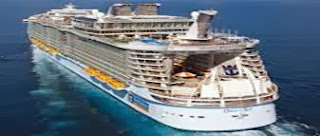 |
| Titanic - Courtesy Google Images |
In the years since that 1912 disaster, ships have gotten bigger. The Disney cruise liner, the Dream, is 1,115 feet long and can carry 5,450 crew and passengers. But she’s not the largest liner in the world; that honor belongs to Royal Caribbean’s sister ships, the Oasis of the Seas and the Allure of the Seas. Both ships are 1,187 feet long and can carry 6,296 people.
Wow! 6,296 people is larger than the crew aboard a United States Navy Nimitz class aircraft carrier.
 |
| Dream - Courtesy Google Images |
 |
| Oasis - Courtesy Google Images |
40,000 full time residents, 30,000 daily visitors, 10,000 nightly hotel guests and 20,000 full time crew. Freedom Ship International calls it The First Mobile City at Sea.
The ship would be so massive that no port in the world could accommodate it. It would complete an around-the-world cruise every two years.
The concept for the Freedom Ship originated in the 1990s. According to Business Insider, at an estimated cost nearing a staggering $10 billion, project investors were scarce. The project was scrapped after the financial crisis in 2008.
 |
| Freedom - Courtesy Google Images |
I’ve seen the Oasis of the Seas up close and I’ve been on the Disney Dream. Both ships are huge; the Dream is so big that it is easy to get lost and turned around once aboard.
I find it difficult to fathom that something that’s more than ¾ of a mile long and 750 feet wide can float. If built, the Freedom Ship would make the Oasis of the Seas look like a tugboat. And, based on what happened to the Titanic, I wonder how many lifeboats it would take to evacuate 100,000 people.
What do you think; would you take a cruise aboard the Freedom Ship?


